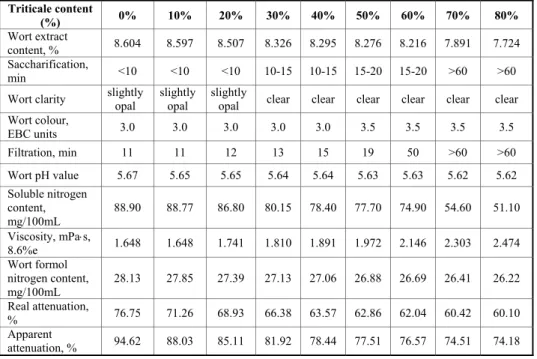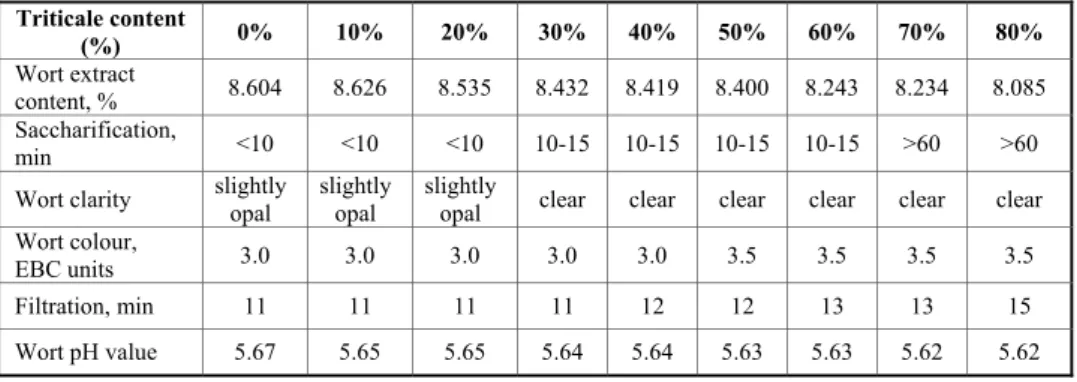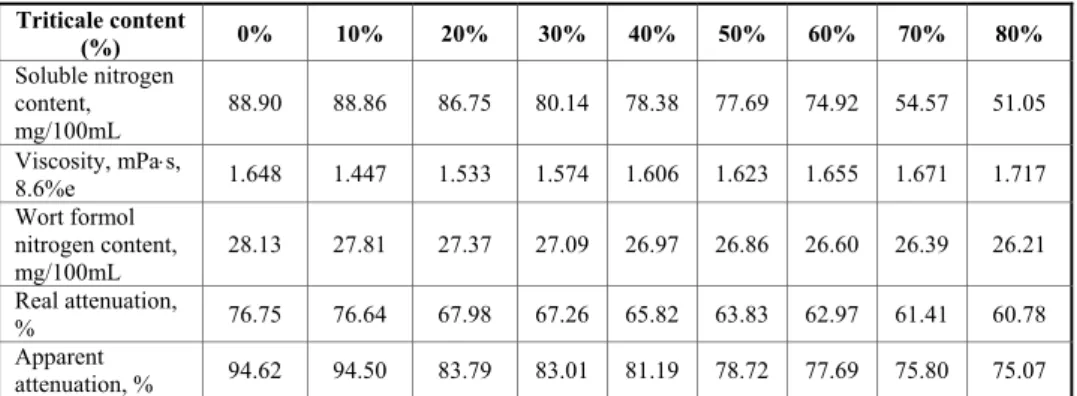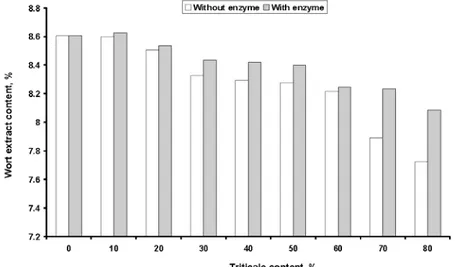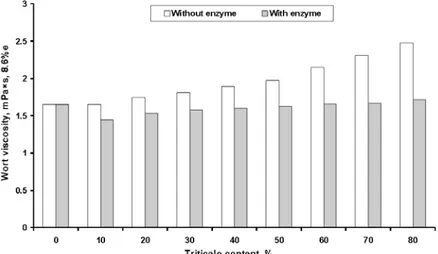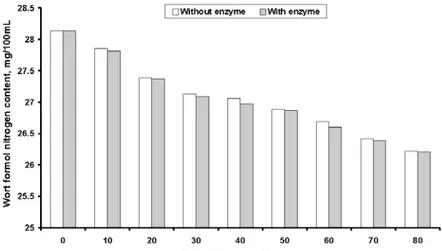THE APPLICATION OF TRITICALE VARIETY ODYSSEY AS THE SUBSTITUTE FOR MALT IN WORT PRODUCTION
Olgica S. Grujić, Jelena D. Pejin and Srbislav S. Denčić
The objective of this work was to investigate the possibility of triticale application as the partial substitute for malt in wort production. For wort production, two series of experiments were performed in which triticale variety Odyssey, from experimental fields, Rimski Šančevi location (Serbia), was used as the substitute for barley malt in grist with and without the addition of commercial enzyme Ultraflo Max (Novozymes, Denmark). Triticale was added in each of the carried series of experiments as the substitute for malt: 0, 10, 20, 30, 40, 50, 60, 70 and 80% in grist. Experiments were carried out on laborato-ry scale by the application of infusion procedure for wort production. Regarding extract content, triticale variety Odyssey could be used as the substitute for malt up to 60% with-out the addition of commercial enzyme Ultraflo Max. With the addition of this enzyme triticale variety Odyssey could be used as a substitute for malt up to 80%, regarding the extract content. With the increase in the content of triticale in the grist, viscosity increa-sed. The addition of commercial enzyme Ultraflo Max significantly reduced wort visco-sity. The obtained results indicate that worts produced with the addition of triticale va-riety Odyssey to grist yielded good analytical quality parameters.
KEYWORDS: Triticale, malt, wort
INTRODUCTION
According to the definition given by the Bavarian law of the purity of beer production (“Reinheitsgebot”) from 1516, beer is the product which must be produced only from malted barley, hops and water, using the brewer’s yeast for fermentation (1). Brewing is a multistage process involving biological conversion of raw materials to final product (2). In modern brewing the use of adjuncts (unmalted cereals) is a well-established procedure (3).
From the technological point of view, an adjunct is primarily employed in brewing to provide carbohydrates that can ultimately be broken down into fermentable sugars, and maximum starch content is clearly desired in the use of a brewing adjunct (4). Adjuncts are also used in beer production to increase beer stability, and possibly to reduce the production costs (5). Despite of the undisputed economic role of adjunct utilization, beer
quality is based on wort composition rather than on wort price. Thus, the brewer needs to ensure that wort prepared from mixed grists of malt and adjuncts does not diminish the traditionally high quality standards (6). Maize and rice are the most commonly used sources of starch-rich brewing adjuncts. Nevertheless, a wide range of other cereals, such as unmalted barley, wheat, or sorghum have also been employed (3).
Triticale (Triticosecale spp. Wittmack), the first man-made cereal, is the product of a cross between wheat (Triticum spp.) and rye (Secale spp.) (6). In modern times, it has been reported that triticale is cultivated in more than 30 countries worldwide (7) on araund 3.7 milion ha in total, yielding more than 12 milion tonnes a year (8). Triticale has agronomic advantages, it can be grown on more marginal land (arid, acidic, etc.) and re-quires less agricultural chemicals (fertilizer, agronomic chemicals, etc.) (9). Recent stu-dies have shown that unmalted triticale may be suitable as a brewing adjunct. Most non-malt adjuncts do not contribute to enzyme activity. However, triticale goes beyond this specification, since some triticale varieties already contain high levels of amylolytic acti-vity in their unmalted natural form, in conjunction with lower levels of proteolytic ac-tivity (10). Because of this and the low gelatinization range (59-65ºC), triticale is capable of degrading its own starch content with the efficiencies roughly equal to those of barley malt (3). Besides amylolysis and proteolysis, the degradation of non-starch polysaccha-rides during mashing is considered another essential parameter in brewing. Arabinoxylan and mixed linkage -glucan have been recognised as factors that contribute to wort vis-cosity, decrease wort and beer filtration rates and cause subsequent problems such as haze formation or reduced extraction efficiency (4). When using triticale, mixed linkage -glucans are negligible as a result of their minor content in the grains (11). In contrast, the solubilisation of triticale arabinoxylans slightly increases wort viscosity and may affect beer filtration rates (3, 6). In addition to these quality criteria, Glatthar et al. (6) showed that substantial savings (up to 25% in costs for raw materials) could be achieved by using triticale instead of brewing adjuncts currently in use.
The objective of this paper was to investigate the possibility of triticale application as the partial substitute for malt in wort production. For wort production, two series of ex-periments were performed in which triticale variety Odyssey, from experimental fields, Rimski Šančevi location (Serbia), was used as the substitute for barley malt in grist with and without the addition of commercial enzyme Ultraflo Max (Novozymes, Denmark).
EXPERIMENTAL
in-crease to 70C in 25 minutes; 60 minutes at 70C, cooling to 20C) for wort production. At the shares >40% of triticale, thermal treatment (temperature increase to 90°C; cooling to 70-75°C, addition of 1g of malt; temperature increase to the boiling and kept at this temperature for 10 minutes; cooling to 45°C) was used before the infusion procedure (for starch gelatinization). Triticale, malt and wort analyses were performed using the stan-dard European Brewery Convention, Analytica-EBC (12) and/or MEBAK (13) methods.
RESULTS AND DISSCUSION
Results of malt analyses are given in Table 1. According to analytical parameters of malt analyses presented in Table 1, malt used in these experiments was of good quality.
Table 1. Results of malt analyses
Parameter Malt
Moisture content of grain, % 5.45
Proteins, % DM 10.23
Extract content, fine grist, % DM 80.64
Saccharification, min <10
Wort clarity Slightly opal
Filtration, min 11
Wort colour, EBC units 3.0
Wort pH value 5.67
Wort soluble nitrogen, mg/100 mL 88.90
Viscosity, mPas, 8.6%e 1.648
Wort formol nitrogen content, mg/100mL 28.13
Extract difference, % DM 1.21
Kolbach indice, % 49.24
Hartong VZ 45°C, % 42.20
Real attenuation, % 76.75
Apparent attenuation, % 94.62
DM – dry matter
Table 2. Results of triticale variety Odyssey analyses (as an adjunct)
Parameter Odyssey
Moisture content of grain, % 10.06
Protein content, %DM 12.65
Extract content, fine grist, % DM 78.23
Saccharification, min 15-20
Wort clarity clear
Filtration, min 20
Wort colour, EBC units 3.5
Wort pH value 5.62
Wort soluble nitrogen, mg/100 mL 80.51
Viscosity, mPas, 8.6%e 1.959
Wort formol nitrogen content, mg/100mL 26.85
Real attenuation, % 63.11
Apparent attenuation, % 77.93
DM – dry matter
The results of the worts analyses produced with triticale variety Odyssey are given in Table 3.
Table 3. Results of worts analyses produced with triticale variety Odyssey
Triticale content
(%) 0% 10% 20% 30% 40% 50% 60% 70% 80%
Wort extract
content, % 8.604 8.597 8.507 8.326 8.295 8.276 8.216 7.891 7.724 Saccharification,
min <10 <10 <10 10-15 10-15 15-20 15-20 >60 >60 Wort clarity slightly
opal
slightly opal
slightly
opal clear clear clear clear clear clear Wort colour,
EBC units 3.0 3.0 3.0 3.0 3.0 3.5 3.5 3.5 3.5
Filtration, min 11 11 12 13 15 19 50 >60 >60
Wort pH value 5.67 5.65 5.65 5.64 5.64 5.63 5.63 5.62 5.62 Soluble nitrogen
content, mg/100mL
88.90 88.77 86.80 80.15 78.40 77.70 74.90 54.60 51.10
Viscosity, mPas,
8.6%e 1.648 1.648 1.741 1.810 1.891 1.972 2.146 2.303 2.474 Wort formol
nitrogen content, mg/100mL
28.13 27.85 27.39 27.13 27.06 26.88 26.69 26.41 26.22
Real attenuation,
% 76.75 71.26 68.93 66.38 63.57 62.86 62.04 60.42 60.10 Apparent
Substituting a share of malt with triticale variety Odyssey, the characteristic quality parameters of worts changed compared to the control wort produced of malt only as follows (Table 3):
- control malt yielded the highest extract content. Substitution of malt with triti-cale from 10% up to 80% resulted in a uniform extract decrease with increase of triticale share in grist (10.23% decrease at 80% of triticale share compared to the control wort);
- saccharification time was too high when the share of triticale was higher than 50%, whereas in case of 70 and 80% of triticale in grist the saccharification was nonsatisfactory and unacceptable;
- substitution of malt with triticale, 30-80%, had possitive influence on wort cla-rity;
- substitution of malt with triticale from 10% to 80% resulted in wort colour in-crease with the inin-crease of triticale share in grist;
- filtration rate significantly increased when 60, 70 and 80% of malt was substi-tuted with triticale;
- wort pH value slightly decreased with the increase of triticale share;
- wort soluble nitrogen content decreased with the increase of triticale content in wort (42.61% decrease at 80% of triticale share compared to the control wort);
- wort viscosity increased uniformly with the increase of triticale share (50.12% increase at 80% of triticale share compared to the control wort), reaching very high levels at 50, 60, 70 and 80%;
- wort formol nitrogen content slightly decreased with the increase of triticale sha-re in grist (6.79% decsha-rease at 80% of triticale shasha-re compasha-red to the control wort), and
- real and apparent wort attenuation decreased with the increase in triticale content in wort.
The results of the worts analyses produced with triticale variety Odyssey and with the application of enzyme Ultraflo Max are given in Table 4.
Table 4. Results of worts analyses produced with triticale variety Odyssey and enzyme Ultraflo Max
Triticale content
(%) 0% 10% 20% 30% 40% 50% 60% 70% 80%
Wort extract
content, % 8.604 8.626 8.535 8.432 8.419 8.400 8.243 8.234 8.085 Saccharification,
min <10 <10 <10 10-15 10-15 10-15 10-15 >60 >60 Wort clarity slightly
opal
slightly opal
slightly
opal clear clear clear clear clear clear Wort colour,
EBC units 3.0 3.0 3.0 3.0 3.0 3.5 3.5 3.5 3.5
Filtration, min 11 11 11 11 12 12 13 13 15
Table 4. Continuation Triticale content
(%) 0% 10% 20% 30% 40% 50% 60% 70% 80%
Soluble nitrogen content, mg/100mL
88.90 88.86 86.75 80.14 78.38 77.69 74.92 54.57 51.05
Viscosity, mPas,
8.6%e 1.648 1.447 1.533 1.574 1.606 1.623 1.655 1.671 1.717 Wort formol
nitrogen content, mg/100mL
28.13 27.81 27.37 27.09 26.97 26.86 26.60 26.39 26.21
Real attenuation,
% 76.75 76.64 67.98 67.26 65.82 63.83 62.97 61.41 60.78 Apparent
attenuation, % 94.62 94.50 83.79 83.01 81.19 78.72 77.69 75.80 75.07 The use of triticale variety Odyssey as the substitute of malt for wort production with the application of enzyme Ultraflo Max caused the changes of characteristic wort quality parameters compared to control wort produced of malt only as follows (Table 4):
- extract content in worts produced with triticale was lower than in control one, and the increase in triticale share caused a uniform extract content decrease (6.03% decrease at 80% of triticale share compared to the control wort);
- saccharification time was satisfactory for triticale shares up to 60%, whereas at 70 and 80% content it was unsatisfactory i.e. it was too long. Saccharification time was lower, up to the 70% malt replacement, comared to the worts produced with-out the application of Ultrflo Max enzyme;
- partial substitution of malt with triticale had a possitive effect on wort clarity change compared to the control one, but no difference was observed compared to the worts produced without the enzyme application;
- slight increase in wort colour was determined as a result of partial malt substi-tution with triticale. The results for the wort colour were identical to those of worts produced without the addition of the enzyme Ultraflo Max;
- filtration time increased slightly at triticale shares 70 and 80%. The filtration time was shorter comared to the samples produced without the addition of the enzyme, especially at higher trticale ratios (60-80%);
- increase of triticale share resulted in a slight decrease of the wort pH but the re-sults were similar to those obtained without the enzyme addition;
- wort soluble nitrogen content decreased with the increase of triticale content in wort (42.58% decrease at 80% of triticale share compared to the control wort);
- 10-50% of triticale in grists caused wort viscosity decrease compared to the con-trol wort, while the viscosity remained at the level of concon-trol wort at 60% of tri-ticale. Wort viscosity increased uniformly with the furhter increase of the triticale share,
- wort formol nitrogen content decreased with increase of triticale share in grist (6.82% decrease at 80% of triticale share compared to the control wort) and
Comparative survey of the results of wort analyses produced by partial substitution of malt with different shares of triticale without and with the addition of enzyme
Ultraflo Max
The influence of different triticale shares and the application of enzyme Ultraflo Max on the wort extract content is presented in Figure 1.
Figure 1. Extract content of the produced worts
The worts produced without the enzyme Ultraflo Max yielded lower extract content compared to those produced with the application of enzyme Ultraflo Max at the same shares and conditions of malt substitution. The increase of triticale share resulted in ex-tract content decrease with and without enzyme addition. With the application of the en-zyme Ultraflo Max, at 80% of triticale share, wort extract content was by 4.67% higher compared to the wort extract content with the same triticale share but without the enzyme addition. Regarding extract content triticale variety Odyssey could be used as the sub-stitute for malt up to 60% without the addition of commercial enzyme Ultraflo Max. With the addition of this enzyme triticale variety Odyssey could be used as a substitute for malt up to 80%, regarding extract content.
The influence of different triticale shares and the application of enzyme Ultraflo Max on the wort viscosity is presented in Figure 2.
addition of this enzyme triticale variety Odyssey could be used as a substitute for malt up to 80%.
Figure 2. Viscosity of the produced worts
The influence of different triticale shares and the application of enzyme Ultraflo Max on the wort soluble nitrogen content is presented in Figure 3.
Figure 3. Soluble nitrogen content of the produced worts
du-ring thermal pretreatment. The addition of the enzyme Ultraflo Max did not have any in-fluence on wort soluble nitrogen content. Regarding soluble nitrogen content, triticale va-riety Odyssey could be used as the substitute for malt up to 30% with and without the addition of the enzyme Ultraflo Max.
The influence of different triticale shares and the application of enzyme Ultraflo Max on the wort formol nitrogen content is presented in Figure 4.
Figure 4. Formol nitrogen content of the produced worts
The worts produced with the enzyme Ultraflo Max yielded slightly lower formol nitrogen content compared to those produced without the application of enzyme at the same shares and conditions of malt substitution. The increase of triticale share resulted in a decrease of the wort formol titration nitrogen content with and without enzyme additi-on. Regarding formol nitrogen content, triticale variety Odyssey could be used as a sub-stitute for malt up to 80% with and without the addition of the enzyme Ultraflo Max.
CONCLUSIONS
Acknowledgement
This work is a part of the Project No. 20139, which is financially supported by the Ministry of Science and Technological Development of the Republic of Serbia.
REFERENCES
1. W. Kunze: Technologie Brauer und Mälzer, VLB Berlin (1998) p 20.
2. G. Walker: Yeast Technology in Yeast Physiology and Biotechnology, John Wiley and Sons, Chichester (1998) pp. 283-284.
3. J. Glatthar, J. Heinisch and T. Senn: A study on the suitability of unmalted triticale as a brewing adjunct. J. Am. Soc. Brew. Chem. 60 4 (2002) 181-187.
4. J. Glatthar, J. Heinisch and T. Senn: Unmalted triticale cultivars as brewing adjuncts: effects of enzyme activities and composition on beer wort quality. J. Sci. Food Agric. 85 4 (2005) 647-654.
5. R. Agu: A comparison of maize, sorghum and barley as brewing adjuncts, J. Inst. Brew. 108 (2002) 19-22.
6. J. Glatthar, J. Heinisch and T. Senn: The use of unmalted triticale in brewing and its effect on wort and beer quality. J. Am. Soc. Brew. Chem. 61 4 (2003) 182-190. 7. M. Mergoun, H. Pfeffer, J. Peña, K. Ammar, S. Rajaram: Triticale crop improvement:
the CIMMYT programme in: Triticale improvement and production (FAO plant pro-duction and protection. 2004; Paper 179 (Edited by Morgoum M and Gómez-Mac-pherson H.), 11-26 Rome: Food and Agriculture Organization of the United Nations. 8. FAO. FAOSTAT, FAO statistical databases - agriculture [WWW document] URL
http://faostat.fao.org/site/567/default.aspx # ancor. Viewed on November 30, 2008. 9. I. Ciftci, E. Yenice and H. Eleroglu: Use of triticale alone and in combination with
wheat or maize: effects of diet type and enzyme supplementation on hen performan-ce, egg quality, organ weights, intestinal viscosity, and digestive system characteris-tics. Anim. Feed Sci. Technol. 105 1-4 (2003) 149-161.
10.D. Goode and E. Arendt: Development in the supply of adjunct materials for brewing, in: Brewing – New technologies. Ed. C. W. Bamforth, Woodhead Publishing Limited and CRC Press LLC, Cambridge (2006) p 43.
11.G. Annemüller, B. Mietla, G. Creydt, F. Rath, R. Schildbach and T. Tuszynski: Triti-cale and tritiTriti-cale malts, part III: First brewing trails with tritiTriti-cale malts, Monatsschrift für Brauwissenschaft. 52 (1999) 131-135.
12.European Brewery Convention, Analytica – EBC, EBC Analysis Committee, Verlag Hans Carl, Getärnke-Fachverlag, Nürnberg (1998) Sections 3 and 4.
ɉɊɂɆȿɇȺɌɊɂɌɂɄȺɅȿȺɋɈɊɌȿɈȾɂɋȿȳɄȺɈɁȺɆȿɇȿɁȺɋɅȺȾɍ
ɉɊɈɂɁȼɈȾȵɂɋɅȺȾɈȼɂɇȿ
. , . , .
.
,
( ),
Ultraflo Max (Novozymes, ).
: 0, 10, 20, 30, 40, 50, 60, 70
80%.
-. ,
60%
Ultra-flo Max, Ultraflo Max
80%.
. Ultraflo Max
-a.
-.

